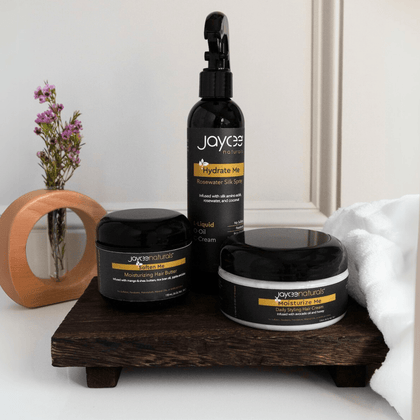

This article explores tips to help your textured hair grow faster and stay healthy. More specifically, how to nourish your scalp and hair, the importance of protective styling, and effective hair care practices. By following these tips, you'll be on your way to achieving the luscious, healthy hair you've always wanted.
Table of Contents
Understanding Textured Hair Growth
Textured hair has unique characteristics that set it apart from other hair types. To grow hair faster, you must understand the challenges and factors affecting its growth.
Unique Challenges
Textured hair tends to be more prone to dryness and breakage. This is because the natural oils produced by your scalp have a more challenging time traveling down the hair shaft due to its coiled structure. As a result, your hair may require extra care and moisture to stay healthy and grow longer.
Growth Cycle
Like all hair types, textured hair follows a growth cycle consisting of three phases: anagen (growing), catagen (transitional), and telogen (resting). The anagen phase is crucial for hair growth and lasts several years for scalp hair. During this phase, hair grows about a centimeter every 28 days [1] . However, the duration of each phase can vary depending on genetics, diet, and overall health.
Factors Affecting Growth
Several factors can impact how fast your textured hair grows:
Genetics: Your genes play a significant role in determining your hair's texture, thickness, and growth rate.
Nutrition: A balanced diet rich in proteins, vitamins, and minerals is essential for healthy hair growth.
Scalp health: A clean, well-nourished scalp provides the best environment for hair growth.
Stress: High stress levels can disrupt the hair growth cycle and increase shedding.
Hair care practices: Proper care, including gentle handling and protective styling, can help prevent breakage and promote length retention.
Understanding these factors will help you develop a tailored approach to grow your textured hair faster and maintain its health. By addressing the unique needs of your hair type, you can create an effective routine that supports healthy growth and length retention.
Nourishing Your Scalp and Hair
Proper nourishing of the scalp and hair is crucial for growing and maintaining healthy hair. This involves providing essential nutrients, using effective hydration techniques, and applying natural oil treatments.
Essential Nutrients
Your hair's health and growth rate depend on various factors, including your diet. Consuming foods rich in vitamins and minerals is vital in the hair follicle growth cycle. To support hair growth, focus on eating a balanced diet that includes:
- Protein-rich foods like eggs, which are essential for hair follicle health
- Berries, which are packed with vitamin C to help produce collagen and strengthen hair
- Fatty fish, such as salmon, which provide omega-3 fatty acids and protein
- Spinach, a great source of iron and vitamins A and C
- Sweet potatoes, rich in beta-carotene, which the body converts to vitamin A
Hydration Techniques
Proper hydration is critical to maintaining healthy, luscious locks. Moisture is vital for textured hair as it helps prevent frizz and enhances definition. To keep your hair hydrated:
- Use a leave-in conditioner or hair mask to lock in moisture
- Spritz your hair with water and a lightweight leave-in conditioner throughout the day
- Minimize heat styling to prevent moisture loss
- Drink plenty of water to promote overall hydration
Natural Oil Treatments
Natural oils can be highly beneficial for nourishing your scalp and hair. Some practical options include:
- Coconut oil: Apply it to the tips of your hair to provide great moisturizing and penetrate the hair shaft
- Argan oil: Rich in vitamins and minerals, it helps make hair softer and more manageable
- Jojoba oil: Its molecular structure is similar to scalp sebum, making it excellent for balancing oil production
Remember, a healthy scalp leads to healthy hair follicles and, ultimately, faster hair growth
Protective Styling for Length Retention
Protective styling is essential for growing hair faster and maintaining healthy hair. Keeping your ends tucked away can prevent breakage and promote length retention. Let's explore some effective protective styling methods for textured hair.
Low Manipulation Styles
Low manipulation styles help minimize the urge to constantly touch and manipulate your hair. This reduction in handling can lead to less frizz, fewer split ends, and decreased breakage. Some great low manipulation styles include:
- Twist-outs
- Loose buns
- Pineapple method
- Bantu knots
These styles protect your hair and open up new styling possibilities, giving you a break from your usual routine.
Proper Braiding Techniques
Braids can be an excellent protective style, but it's essential to use proper techniques to avoid damage. Here are some tips for braiding:
- Avoid tiny braids, as they can cause breakage
- Don't braid too tightly, especially around the edges
- Use extensions sparingly to prevent excess weight on your hair
- Consider cornrowing the front edges to protect this delicate area.
Remember to deep condition your hair thoroughly before braiding and detangle gently to minimize breakage during the styling process.
Nighttime Hair Care
Protecting your hair while you sleep is crucial for length retention. Here are some nighttime care tips:
- Use a satin or silk pillowcase to reduce friction
- Wrap your hair in a silk or satin scarf or bonnet
- Try sleeping with your hair in a loose bun or braid using silk scrunchies
These protective styling techniques can help your textured hair grow faster and stay healthy. Remember to be gentle with your hair and avoid styles that are too tight or cause discomfort
Healthy Hair Care Practices
Adopting proper care practices is crucial for growing hair faster and maintaining healthy hair. Let's explore some essential techniques for keeping your textured hair in top condition.
Gentle Detangling Methods
Detangling is a critical step in your hair care routine. Always start with damp hair and use a wide-tooth comb or your fingers to work through knots gently. Begin at the ends and slowly work your way up to the roots. This method helps prevent breakage and minimizes stress on your hair. For extra slip, apply a leave-in conditioner or detangling spray before combing.
Heat Styling Precautions
While heat styling can give you versatile looks, it's important to use caution to avoid damage. Always apply a heat protectant before using any hot tools. Set your styling tools to the lowest effective temperature for your hair type. Limiting heat styling to once a week or less gives your hair time to recover between sessions. When possible, opt for heat-free styling methods to promote healthier hair growth.
Regular Trims
Although it may seem counterintuitive, regular trims are essential for growing hair faster. Trimming your hair every 10-12 weeks helps remove split ends and prevents them from traveling up the hair shaft. This practice keeps your hair looking healthy and reduces the need for more drastic cuts in the future. Regular trims also make your hair easier to style and manage, contributing to an overall healthier appearance.
Checklist to Grow Healthy Hair
Understand your hair texture
Nourish your scalp and hair
Use protective styling
Detangle with care
Limit heat use
Conclusion
Growing textured hair faster and keeping it healthy requires a holistic approach. By understanding your hair's unique needs, nourishing it properly, and adopting protective styling techniques, you can achieve the long, luscious locks you desire. Remember, patience is key in your hair growth journey, as results may take time to become noticeable.
Consistent care and gentle handling are crucial to maintain your hair's health and promote growth. By sticking to a routine that includes proper nutrition, hydration, and protective practices, you'll be well on your way to achieving your hair goals. Remember that everyone's hair is different, so don't be afraid to experiment and find what works best for you.
Reference
[1] - https://www.austinhairclinic.com/hair-loss-blog/understanding-the-hair-growth-cycle/
Frequently Asked Questions
How long does it typically take for textured hair to see noticeable growth?
The time it takes for textured hair to show noticeable growth varies. If you're starting from a big chop or transitioning from chemically treated hair, it might take around three to four months to see a real change. For some individuals, it could take up to a year to be completely free of chemicals in their hair.
Which type of hair texture has the fastest growth rate?
Asian hair generally has the fastest growth rate, growing about 1.4 centimeters per month. This hair type is typically smooth and ranges from brown to black in color, growing perpendicular to the scalp and having a round and uniform shape.
Does textured hair grow at a slower rate than other hair types?
Textured or curly hair does not inherently grow slower than straight hair. The growth rate of hair is mainly influenced by genetics along with other factors that impact overall hair health such as diet, lifestyle, and hair care routines.
What are some effective methods to accelerate hair growth?
To promote faster hair growth, consider these strategies: regularly trim your hair to prevent split ends, consume protein-rich foods, take supplements that boost hair health, apply strengthening treatments, use hair masks weekly, handle your hair gently after washing, always use heat protection, and shield your hair from environmental damages.





